FIAT BRAVO 2015 2.G Owners Manual
Manufacturer: FIAT, Model Year: 2015, Model line: BRAVO, Model: FIAT BRAVO 2015 2.GPages: 275, PDF Size: 7.55 MB
Page 201 of 275
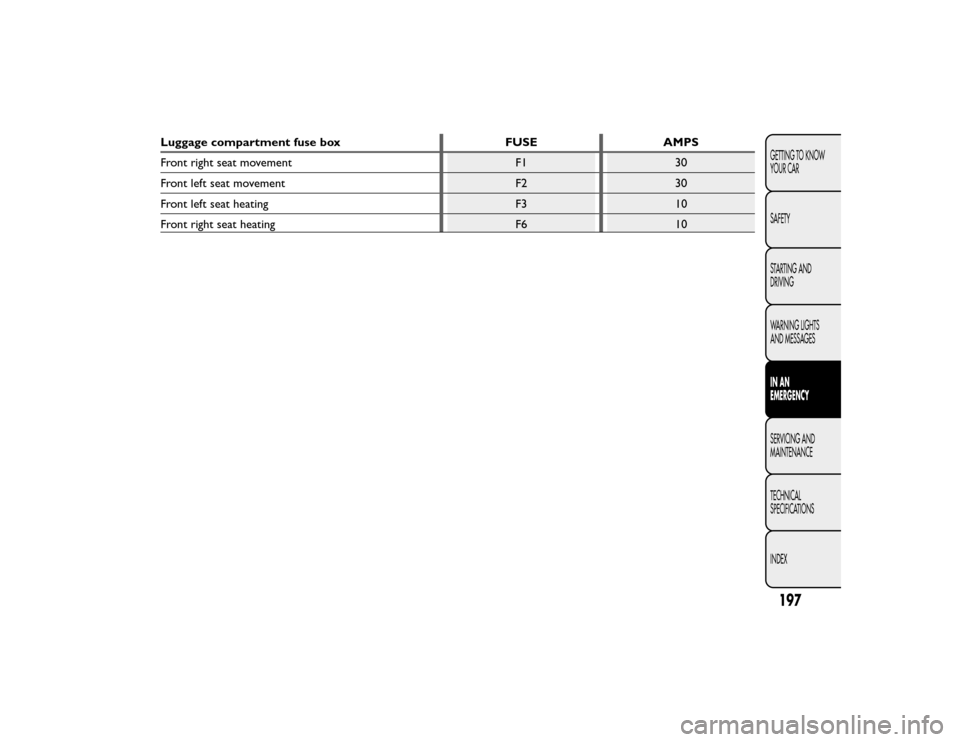
Luggage compartment fuse boxFUSEAMPS
Front right seat movement F130
Front left seat movement F230
Front left seat heating F310
Front right seat heating F610
197GETTING TO KNOW
YOUR CAR
SAFETY
STARTING AND
DRIVING
WARNING LIGHTS
AND MESSAGES
IN AN
EMERGENCY
SERVICING AND
MAINTENANCE
TECHNICAL
SPECIFICATIONS
INDEX
Page 202 of 275
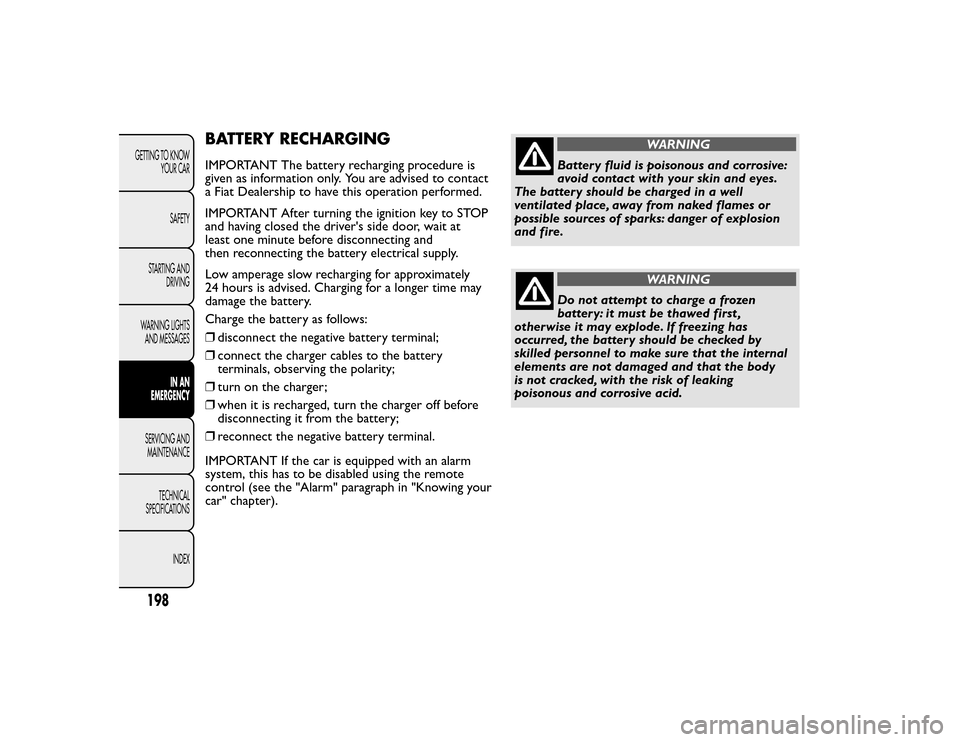
BATTERY RECHARGINGIMPORTANT The battery recharging procedure is given as information only. You are advised to contacta Fiat Dealership to have this operation performed. Low amperage slow recharging for approximately 24 hours is advised. Charging for a longer time maydamage the battery. Charge the battery as follows:❒
disconnect the negative battery terminal;
❒
connect the charger cables to the battery terminals, observing the polarity;
❒
turn on the charger;
❒
when it is recharged, turn the charger off beforedisconnecting it from the battery;
❒
reconnect the negative battery terminal.
IMPORTANT If the car is equipped with an alarmsystem, this has to be disabled using the remotecontrol (see the "Alarm" paragraph in "Knowing yourcar" chapter).
WARNING
Battery fluid is poisonous and corrosive:avoid contact with your skin and eyes.
The battery should be charged in a wellventilated place, away from naked flames orpossible sources of sparks: danger of explosionand fire.
WARNING
Do not attempt to charge a frozenbattery: it must be thawed first ,
otherwise it may explode. If freezing hasoccurred, the battery should be checked byskilled personnel to make sure that the internalelements are not damaged and that the bodyis not cracked, with the risk of leakingpoisonous and corrosive acid.
198GETTING TO KNOW
YOUR CARSAFETY
STARTING AND
DRIVING
WARNING LIGHTSAND MESSAGES
IN AN
EMERGENCYSERVICING ANDMAINTENANCETECHNICAL
SPECIFICATIONS
INDEX
IMPORTANT After turning the ignition key to STOP and having closed the driver's side door, wait atleast one minute before disconnecting andthen reconnecting the battery electrical supply.
Page 203 of 275
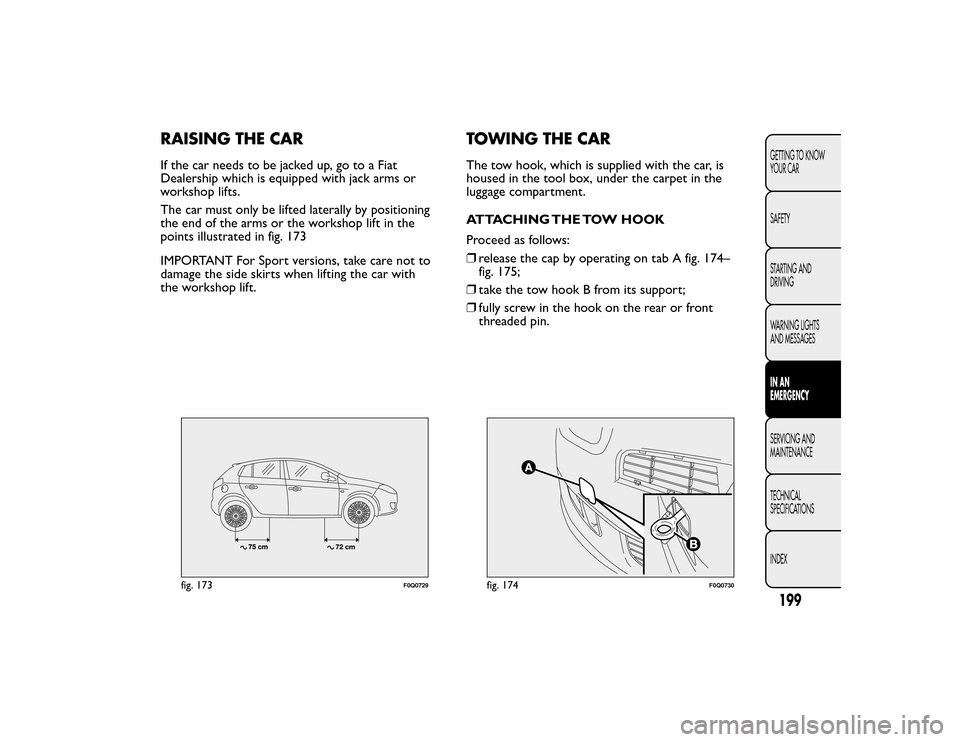
RAISING THE CARIf the car needs to be jacked up, go to a Fiat
Dealership which is equipped with jack arms or
workshop lifts.
The car must only be lifted laterally by positioning
the end of the arms or the workshop lift in the
points illustrated in fig. 173
IMPORTANT For Sport versions, take care not to
damage the side skirts when lifting the car with
the workshop lift.
TOWING THE CARThe tow hook, which is supplied with the car, is
housed in the tool box, under the carpet in the
luggage compartment.
ATTACHING THE TOW HOOK
Proceed as follows:
❒release the cap by operating on tab A fig. 174–
fig. 175;
❒ take the tow hook B from its support;
❒ fully screw in the hook on the rear or front
threaded pin.
fig. 173
F0Q0729
fig. 174
F0Q0730
199GETTING TO KNOW
YOUR CAR
SAFETY
STARTING AND
DRIVING
WARNING LIGHTS
AND MESSAGES
IN AN
EMERGENCY
SERVICING AND
MAINTENANCE
TECHNICAL
SPECIFICATIONS
INDEX
Page 204 of 275
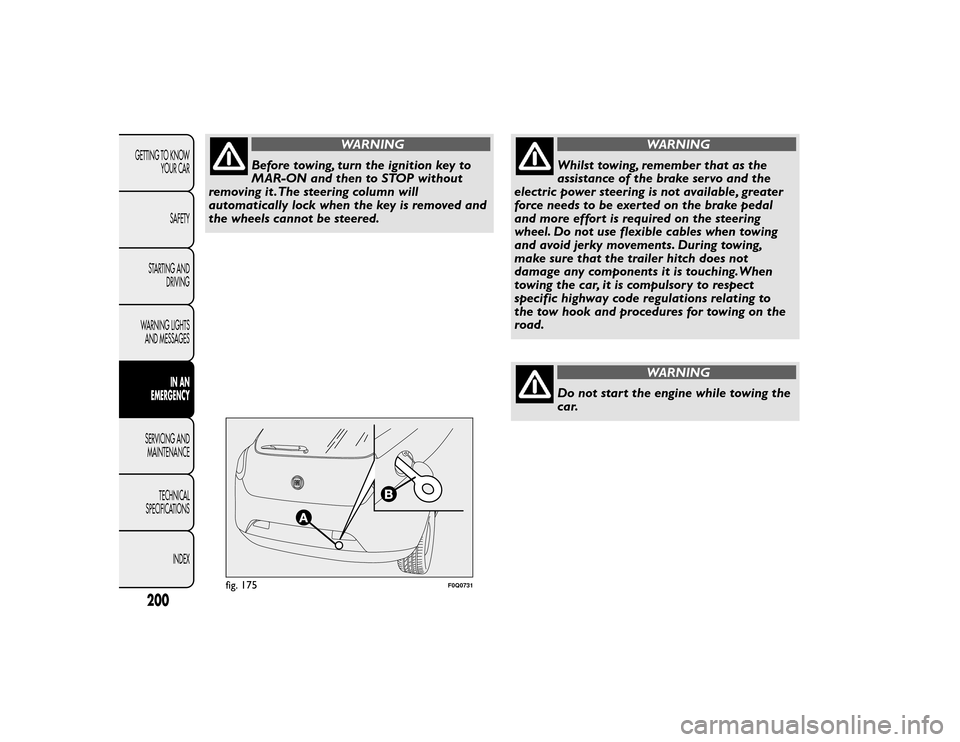
WARNING
Before towing, turn the ignition key to
MAR-ON and then to STOP without
removing it .The steering column will
automatically lock when the key is removed and
the wheels cannot be steered.
WARNING
Whilst towing, remember that as the
assistance of the brake servo and the
electric power steering is not available, greater
force needs to be exerted on the brake pedal
and more effort is required on the steering
wheel. Do not use flexible cables when towing
and avoid jerky movements. During towing,
make sure that the trailer hitch does not
damage any components it is touching.When
towing the car, it is compulsor y to respect
specific highway code regulations relating to
the tow hook and procedures for towing on the
road.WARNING
Do not start the engine while towing the
car.
fig. 175
F0Q0731
200GETTING TO KNOW YOUR CAR
SAFETY
STARTING AND DRIVING
WARNING LIGHTS AND MESSAGES
IN AN
EMERGENCY
SERVICING AND MAINTENANCE
TECHNICAL
SPECIFICATIONS
INDEX
Page 205 of 275
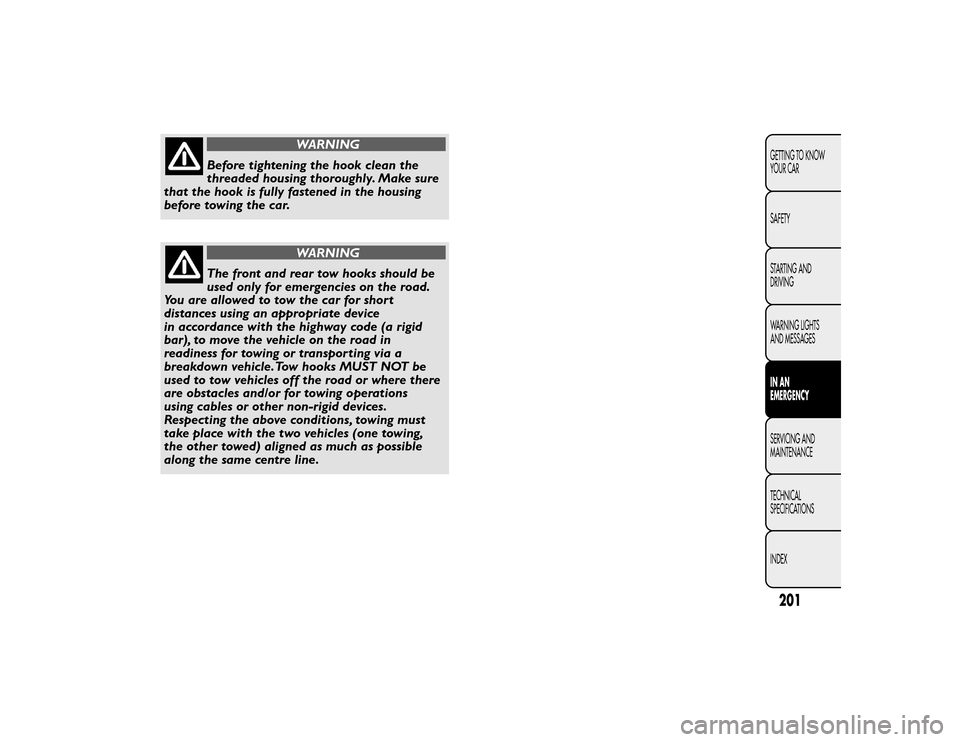
WARNING
Before tightening the hook clean the
threaded housing thoroughly. Make sure
that the hook is fully fastened in the housing
before towing the car.WARNING
The front and rear tow hooks should be
used only for emergencies on the road.
You are allowed to tow the car for short
distances using an appropriate device
in accordance with the highway code (a rigid
bar), to move the vehicle on the road in
readiness for towing or transporting via a
breakdown vehicle.Tow hooks MUST NOT be
used to tow vehicles off the road or where there
are obstacles and/or for towing operations
using cables or other non-rigid devices.
Respecting the above conditions, towing must
take place with the two vehicles (one towing,
the other towed) aligned as much as possible
along the same centre line.
201GETTING TO KNOW
YOUR CAR
SAFETY
STARTING AND
DRIVING
WARNING LIGHTS
AND MESSAGES
IN AN
EMERGENCY
SERVICING AND
MAINTENANCE
TECHNICAL
SPECIFICATIONS
INDEX
Page 206 of 275
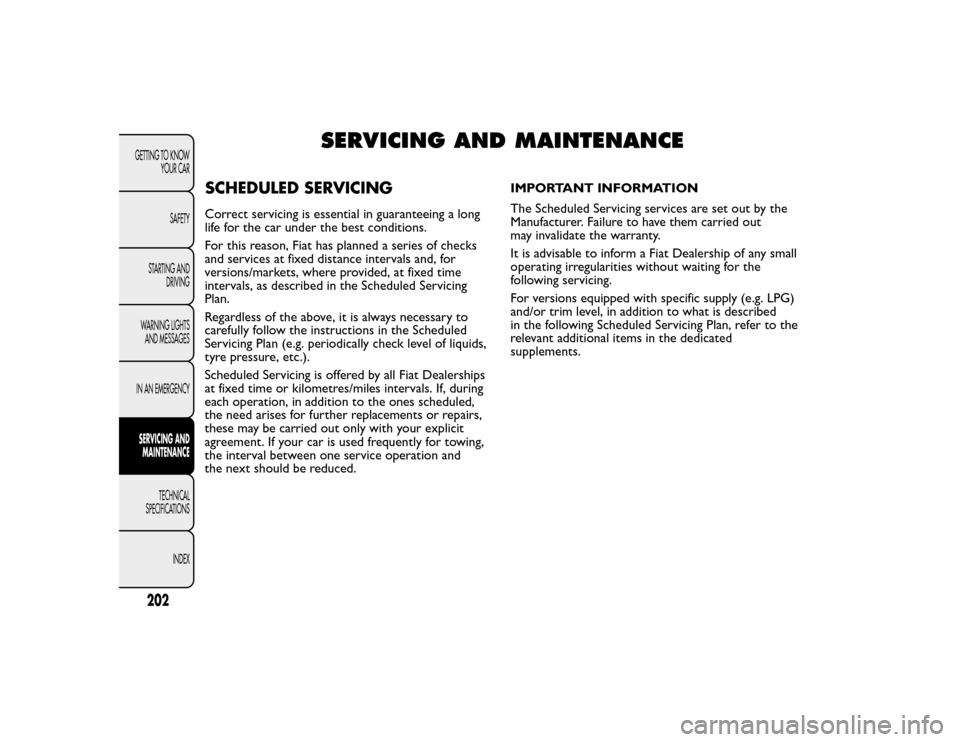
SERVICING AND MAINTENANCE
SCHEDULED SERVICING
202GETTING TO KNOW
YOUR CARSAFETY
STARTING AND
DRIVING
WARNING LIGHTSAND MESSAGESIN AN EMERGENCYSERVICING ANDMAINTENANCE
TECHNICAL
SPECIFICATIONS
INDEX
Correct servicing is essential in guaranteeing a long life for the car under the best conditions. For this reason, Fiat has planned a series of checks and services at fixed distance intervals and, forversions/markets, where provided, at fixed timeintervals, as described in the Scheduled ServicingPlan. Regardless of the above, it is always necessary to carefully follow the instructions in the ScheduledServicing Plan (e.g. periodically check level of liquids,tyre pressure, etc.). Scheduled Servicing is offered by all Fiat Dealerships at fixed time or kilometres/miles intervals. If, duringeach operation, in addition to the ones scheduled,the need arises for further replacements or repairs,these may be carried out only with your explicit
agreement. If your car is used frequently for towing, the interval between one service operation andthe next should be reduced. IMPORTANT INFORMATION The Scheduled Servicing services are set out by the Manufacturer. Failure to have them carried outmay invalidate the warranty. It is advisable to inform a Fiat Dealership of any small operating irregularities without waiting for thefollowing servicing. For versions equipped with specific supply (e.g. LPG) and/or trim level, in addition to what is describedin the following Scheduled Servicing Plan, refer to therelevant additional items in the dedicatedsupplements.
Page 207 of 275
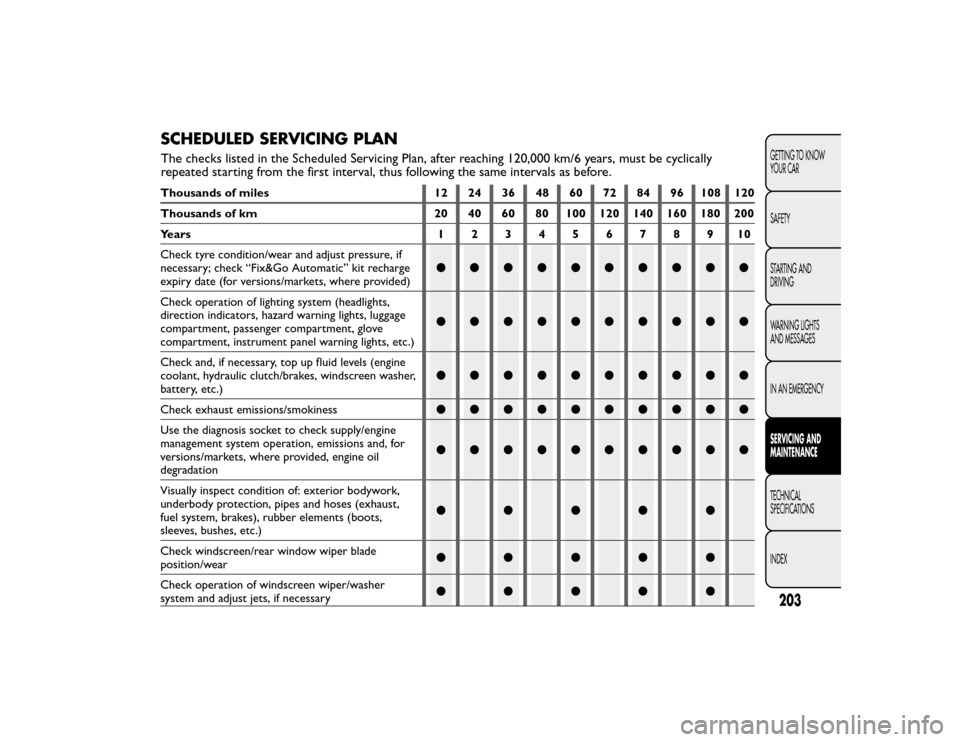
SCHEDULED SERVICING PLAN
203GETTING TO KNOW YOUR CAR SAFETYSTARTING AND DRIVING WARNING LIGHTS AND MESSAGES IN AN EMERGENCYSERVICING AND MAINTENANCE TECHNICAL SPECIFICATIONS INDEX
Thousandsofmiles
12
2
3
60
72
84
96
108
120
Thousands of km 20 40 60 80 100 120 140 160 180 200Years
12345678910
Check tyre condition/wear and adjust pressure, if necessary; check “Fix&Go Automatic” kit rechargeexpiry date (for versions/markets, where provided)
●●●●●●●●●●
Check operation of lighting system (headlights, direction indicators, hazard warning lights, luggagecompartment, passenger compartment, glovecompartment, instrument panel warning lights, etc.)
●●●●●●●●●●
Check and, if necessary, top up fluid levels (engine coolant, hydraulic clutch/brakes, windscreen washer,battery, etc.)
●●●●●●●●●●
Check exhaust emissions/smokiness
●●●●●●●●●●
Use the diagnosis socket to check supply/engine management system operation, emissions and, forversions/markets, where provided, engine oildegradation
●●●●●●●●●●
Visually inspect condition of: exterior bodywork, underbody protection, pipes and hoses (exhaust,fuel system, brakes), rubber elements (boots,sleeves, bushes, etc.)
●●●●●
Check windscreen/rear window wiper blade position/wear
●●●●●
Check operation of windscreen wiper/washer system and adjust jets, if necessary
●●●●●
4
648
The checks listed in the Scheduled Servicing Plan, after reaching 120,000 km/6 years, must be cyclically repeated starting from the first interval, thus following the same intervals as before.
Page 208 of 275
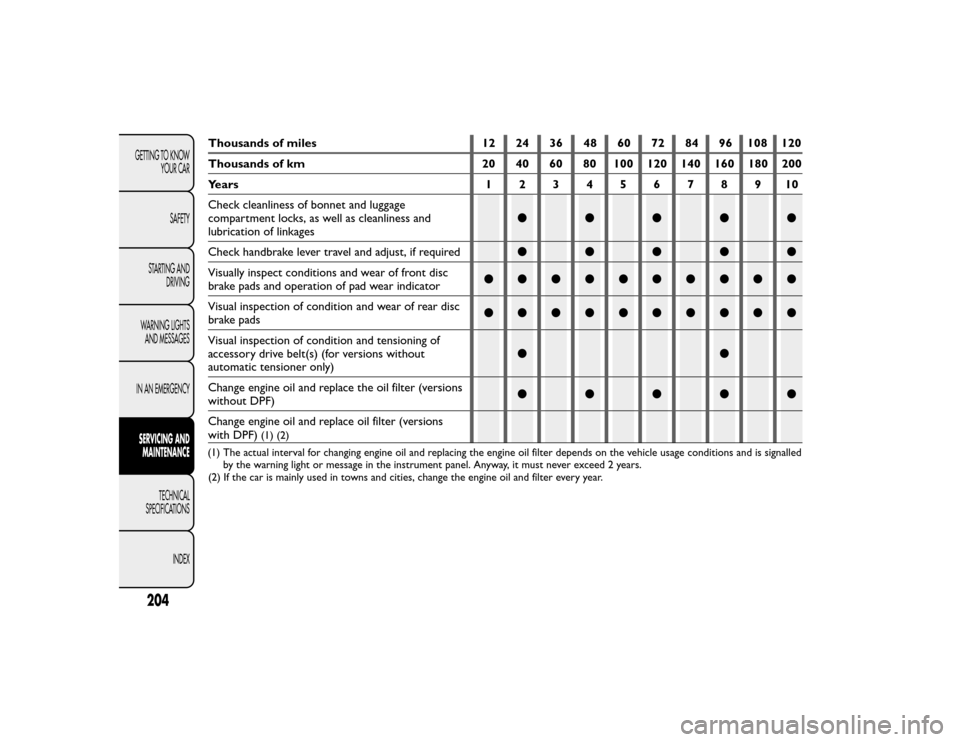
204GETTING TO KNOW
YOUR CARSAFETY
STARTING AND
DRIVING
WARNING LIGHTSAND MESSAGESIN AN EMERGENCYSERVICING ANDMAINTENANCE
TECHNICAL
SPECIFICATIONS
INDEX
Thousandsofmiles
12
2
3
6
7
8
9
1
12
Thousands of km 20 40 60 80 100 120 140 160 180 200Years
12345678910
Check cleanliness of bonnet and luggage compartment locks, as well as cleanliness andlubrication of linkages
●●●●●
Check handbrake lever travel and adjust, if required
●●●●●
Visually inspect conditions and wear of front disc brake pads and operation of pad wear indicator
●●●●●●●●●●
Visual inspection of condition and wear of rear disc brake pads
●●●●●●●●●●
Visual inspection of condition and tensioning of accessory drive belt(s) (for versions withoutautomatic tensioner only)
●●
Change engine oil and replace the oil filter (versions without DPF)
●●●●●
Change engine oil and replace oil filter (versions with DPF)
(1) (2)
(2) If the car is mainly used in towns and cities, change the engine oil and filter every year.
4
6
48
0
2
4
6
08
0
(1) The actual interval for changing engine oil and replacing the engine oil filter depends on the vehicle usage conditions and is signalled
by the warning light or message in the instrument panel. Anyway, it must never exceed 2 years.
Page 209 of 275
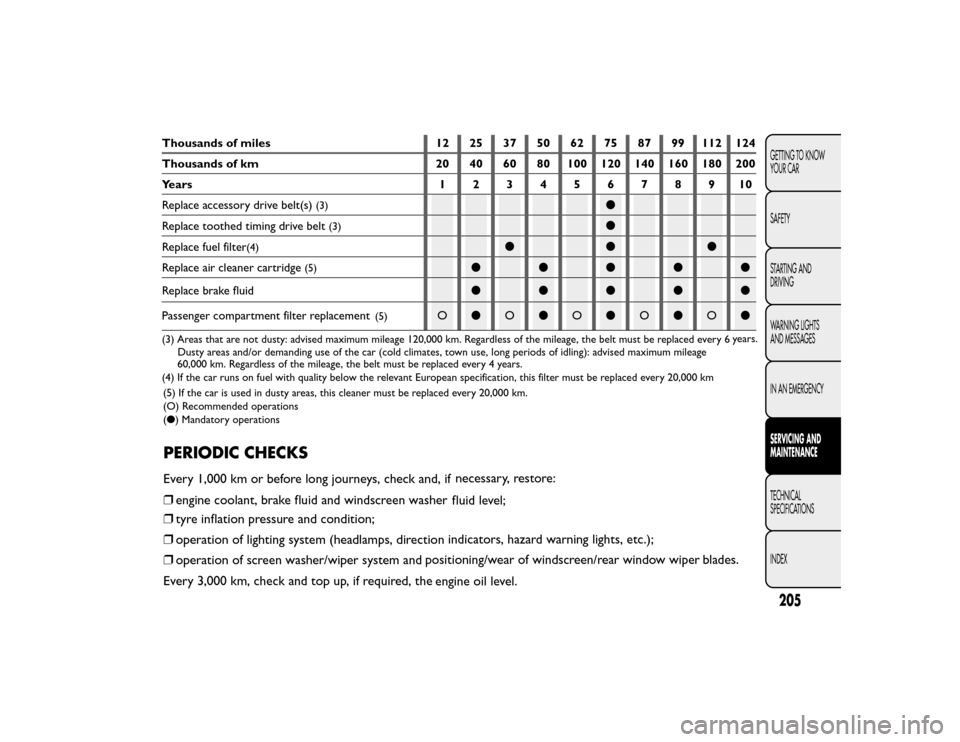
205GETTING TO KNOWYOUR CAR SAFETYSTARTING AND DRIVING WARNING LIGHTS AND MESSAGES IN AN EMERGENCYSERVICING AND MAINTENANCE TECHNICAL SPECIFICATIONS INDEX
PERIODIC CHECKSEvery 1,000 km or before long journeys, check and, if necessary, restore: ❒
engine coolant, brake fluid and windscreen washer fluid level;
❒
tyre inflation pressure and condition;
❒
operation of lighting system (headlamps, directionindicators, hazard warning lights, etc.);
❒
operation of screen washer/wiper system andpositioning/wear of windscreen/rear window wiperblades.
Every 3,000 km, check and top up, if required, theengine oil level.
Thousands of miles 12 25 37 50 62 75 87 99 112 124 Thousands of km 20 40 60 80 100 120 140 160 180 200Years
12345678910
Replace accessory drive belt(s)
(3)
●
Replace toothed timing drive belt
(3)
●
Replace fuel filter
(4)
●●●
Replace air cleaner cartridge
(5)
●●●●●
Replace brake fluid
●●●●●
Passenger compartment filter replacement
(5)
O
●
O
●
O
●
O
●
O
●
(3) Areas that are not dusty: advised maximum mileage 120,000 km. Regardless of the mileage, the belt must be replaced every 6
years. Dusty areas and/or demanding use of the car (cold climates, town use, long periods of idling): advised maximum mileage 60,000 km. Regardless of the mileage, the belt must be replaced every 4 years.
(4) If the car runs on fuel with quality below the relevant European specification, this filter must be replaced every 20,000 km(5) If the car is used in dusty areas, this cleaner must be replaced every 20,000 km.(O) Recommended operations( ●) Mandatory operations
Page 210 of 275
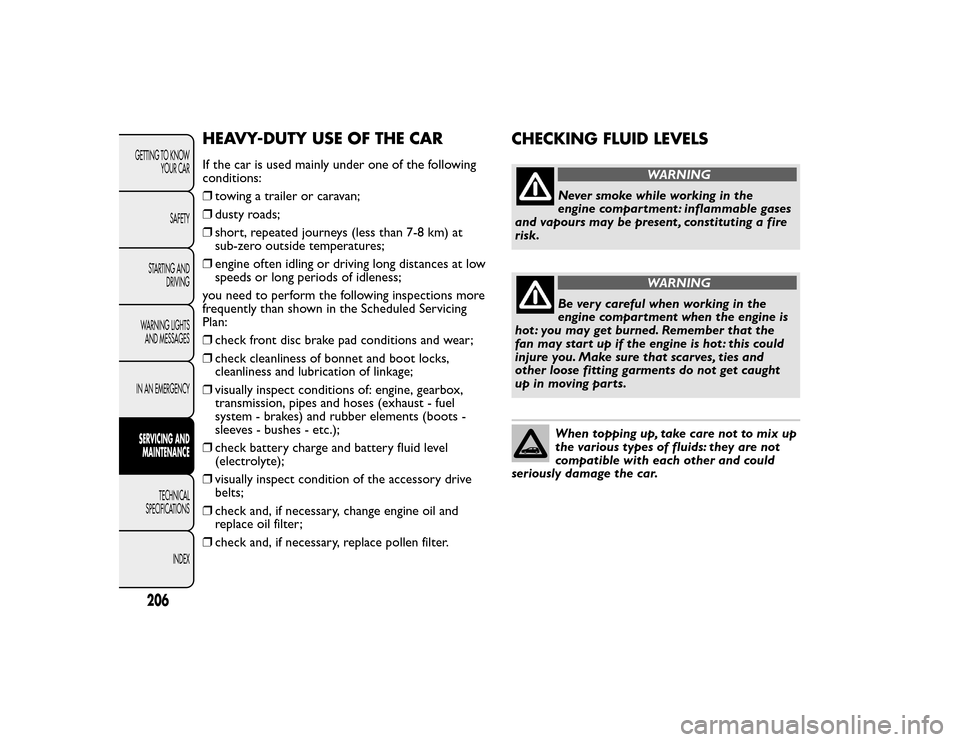
CHECKING FLUID LEVELS
WARNING
Never smoke while working in the engine compartment : inflammable gases
and vapours may be present , constituting a firerisk.
WARNING
Be very careful when working in theengine compartment when the engine is
hot : you may get burned. Remember that thefan may start up if the engine is hot : this couldinjure you. Make sure that scarves, ties andother loose fitting garments do not get caughtup in moving parts.
When topping up, take care not to mix upthe various types of fluids: they are notcompatible with each other and could
seriously damage the car.
206GETTING TO KNOW
YOUR CARSAFETY
STARTING AND
DRIVING
WARNING LIGHTSAND MESSAGESIN AN EMERGENCYSERVICING ANDMAINTENANCE
TECHNICAL
SPECIFICATIONS
INDEX
HEAVY-DUTY USE OF THE CARIf the car is used mainly under one of the followingconditions: ❒
towing a trailer or caravan;
❒
dusty roads;
❒
short, repeated journeys (less than 7-8 km) at sub-zero outside temperatures;
❒
engine often idling or driving long distances at lowspeeds or long periods of idleness;
you need to perform the following inspections morefrequently than shown in the Scheduled ServicingPlan: ❒
check front disc brake pad conditions and wear;
❒
check cleanliness of bonnet and boot locks, cleanliness and lubrication of linkage;
❒
visually inspect conditions of: engine, gearbox,transmission, pipes and hoses (exhaust - fuelsystem - brakes) and rubber elements (boots -sleeves - bushes - etc.);
❒
check battery charge and battery fluid level(electrolyte);
❒
visually inspect condition of the accessory drivebelts;
❒
check and, if necessary, change engine oil andreplace oil filter;
❒
check and, if necessary, replace pollen filter.